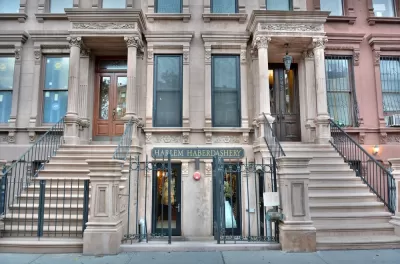As the end of federal and state eviction moratoriums looms, renters who fell behind on payments during the pandemic now face "staggering" amounts of debt.

Renters who fell behind during the pandemic "face staggering debts," with many teetering on the edge of eviction, writes Stefanos Chen for the New York Times. According to a report from NYU's Furman Center that analyzed low-income New York renter households, "the average rent owed by households with arrears through the year ending February 2021 jumped 66 percent." Additionally, "[t]he share of households that owed more than $3,000 increased 65.5 percent, to 2,059 from 1,244; and the share of households owing $10,000 or more jumped 140 percent, to 672 from 280."
As with other aspects of the pandemic, communities of color have been disproportionately affected. "A recent study of state court data found that predominantly Black and Latino neighborhoods, where a disproportionately high number of Covid cases have been reported, had nearly four times the rate of eviction filings."
"[T]he sharp rise in debt for those who have fallen behind is alarming for both tenants, who could face imminent eviction, and landlords, who are unlikely to recoup a sizable share of rent, because it is owed by the city’s most overburdened renters." New York state's eviction moratorium, meanwhile, is set to end on August 31. A $2.4-billion state Emergency Rental Assistance program is scheduled to start accepting applications in June.
FULL STORY: Low-Income Renters Who Fell Behind Face Staggering Debts

Planetizen Federal Action Tracker
A weekly monitor of how Trump’s orders and actions are impacting planners and planning in America.

Maui's Vacation Rental Debate Turns Ugly
Verbal attacks, misinformation campaigns and fistfights plague a high-stakes debate to convert thousands of vacation rentals into long-term housing.

Cuomo Is the Candidate of Both NIMBYs and Developers. What Gives?
In the New York City mayoral race, odd bedfellows align to preserve the housing status quo.

The Subversive Car-Free Guide to Trump's Great American Road Trip
Car-free ways to access Chicagoland’s best tourist attractions.

San Antonio and Austin are Fusing Into one Massive Megaregion
The region spanning the two central Texas cities is growing fast, posing challenges for local infrastructure and water supplies.

Charlottesville Temporarily Has No Zoning Code
A judge ordered the Virginia city to throw out its newly revised zoning code, leaving permitting for new development in legal limbo.
Urban Design for Planners 1: Software Tools
This six-course series explores essential urban design concepts using open source software and equips planners with the tools they need to participate fully in the urban design process.
Planning for Universal Design
Learn the tools for implementing Universal Design in planning regulations.
Heyer Gruel & Associates PA
JM Goldson LLC
Custer County Colorado
City of Camden Redevelopment Agency
City of Astoria
Transportation Research & Education Center (TREC) at Portland State University
Jefferson Parish Government
Camden Redevelopment Agency
City of Claremont





























